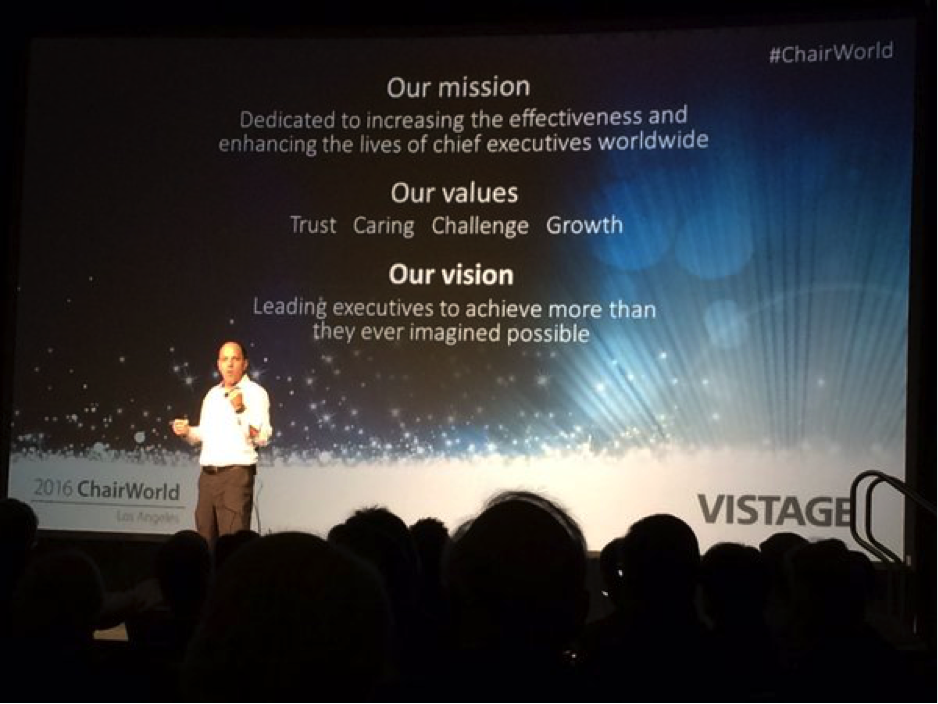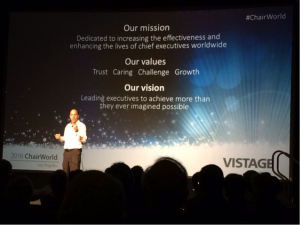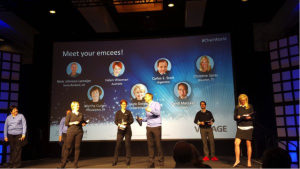Leadership Catalyst Blog

ChairWorld 2016 – Vistage Chairs Gathered in LA to “Sharpen the Saw” Together
Coaching, Human Capital, Leadership Development / 25.02.2016
What am I doing to continuously up my game? This question was top of mind as Vistage CEO Peer Advisory Board Facilitators from around the world gathered in Los Angeles earlier this month for ChairWorld 2016.
As a Vistage Chair and long time CEO coach, I frequently advise and assist my Vistage members and executive coaching clients as they work through stressful business challenges and weigh major decisions with company wide implications. I have the privilege of influencing the few that influence the many. For people like myself who are in the business of giving advice and facilitating issue resolution for a living, it can be easy to forget that even the best coaches and advisors in the field need to actively seek opportunities to up our game and build our knowledge banks so that we can bring more value to our clients and for our own good.
I appreciate that Vistage recognizes the importance of continuously “sharpening the saw” and provides opportunities such as ChairWorld for their professional chairs to do so. This is a key differentiator for Vistage as compared to many other chief executive peer group models.
Over 525 Vistage Chairs from all around the world came together for ChairWorld with the focus on how to improve as leaders and facilitators, learning from each other and fostering a stronger community. There were excellent keynote speakers, numerous breakout sessions to choose from, small-group workshops, formal and informal networking opportunities, and fun social events planned in the evenings.
The highlights of the conference for me included:
- Keynote address on leadership through adversity by polar explorer and top-rated Vistage speaker “Antarctic Mike” Pierce. Mike is the speaker that I have brought in to anchor my 4 Vistage Group meetings this week, and after listening to his talk at ChairWorld I know that my Vistage members are in for a treat.
- Breakout session on putting together a deal team when selling a business, led by legal and financial experts representing the buy and sell sides of transactions. A key question discussed was “how much lead time do you need for an exit” – a topic that I know to be relevant for some of my Vistage members.
- Dinner with the Vistage Colorado chairs – the Denver business climate is similar to Minneapolis in many ways. It was great to get to know the Colorado Vistage team better and to learn more about some of the innovative things that they are doing while also sharing the unique ways that the Minnesota team has been collaborating.
- Leading a “Wisdom Walk” session which paired chairs up to practice 1:1 coaching techniques so that the chairs could learn from each other
- Spending time with Lance Desceurez, the recipient of this year’s Vistage Pope Award which goes to the one chair out of 800 that best exemplifies our values and epitomizes the impact we as chairs strive for Lance is a good friend and mentor, and I know he will continue to help me raise my game as a chair this year.
One of my goals coming into ChairWorld was to look for opportunities around how I can improve my daily and monthly meetings with my members. Specifically, how I can inject more energy into my meetings and go deeper on issue processing to help my Vistage members and coaching clients understand the self-limiting beliefs that are holding them and their businesses back. I was also hoping to expand my Vistage community, increasing the number of chairs who I could pick up the phone and call as a friend, to talk through whatever the latest business issue or ideas we might have.
My experience at ChairWorld 2016 did not disappoint, and I am already applying my new learnings and building on new friendships.
So my question to all of my members and readers is: What are you doing to sharpen your saws? What is your version of Chairworld? Do you have a mentor or coach who is challenging you and helping you to become the best version of yourself. World class athletes have coaches to challenge them and keep them performing at the highest level – why shouldn’t you as a highly successful executive?
Read More >>
New Ammunition in the Twin Cities War for Talent
All Blog Posts, Talent Acquisition, Talent Management / 10.03.2015
For decades recruiters have known that it is really hard to get people to move to the twin cities but that once they do it’s impossible to get them to leave. An article in the March 2015 issue of the Atlantic entitled “The Miracle of Minneapolis” penned by Derek Thompson highlights a compelling economic reason behind this adage: no other city mixes affordability, opportunity, and wealth so well.
Minneapolis – St. Paul was one of only three major metro areas to be on two top 10 economic lists that recently came out. The first is a Trulia study that looked at homeowners’ monthly payments in each city relative to the areas median income. The second a Harvard-Berkeley study examining which cities have the highest intergenerational mobility. Many metropolitan areas seem to have caused a trap for their younger residents in which they cannot afford housing and find a job that positions them well for the future. The Twin Cities seems to have realized both affordable housing and upward job mobility.
Other top ten lists that the Twin Cities makes such as the most bike friendly city, Money’s best place to live, and most fit city are just icing on the cake. The fact that young families can come here for great careers and affordable housing is very compelling value proposition for millennials and this article is a great arrow in your quiver for attracting top talent.
How has the Twin Cities done this and continued to make its mark as a strong business friendly region? According to Thompson, “The Twin Cities’ housing and tax-sharing policies have resulted in lots of good neighborhoods with good schools that are affordable for young graduates and remain nice to live in even as their paychecks rise. This, in turn, has nurtured a deep bench of 30- and 40-something managers, who support the growth of large companies, and whose taxes flow to poorer neighborhoods, where families have relatively good odds of moving into the middle class.”
A fact often touted in the region is that the Twin Cities has more Fortune 500 companies per capita than any other metropolitan area. One strong reason for this is the deep blend of 30 and 40 something talented middle managers that help build and grow those companies.
As you recruit out of state talent for your business, let them know that the Twin Cities, along with your company, is a place that grows, fosters and retains talent like no place else.
Read More >>Vistage member recognized for his commitment to developing his people
All Blog Posts, Motivation, Talent Management / 07.02.2013
Too many entrepreneurs hit a growth ceiling because they fail to build a strong leadership team beneath them. Vistage members know that to grow their business, they need to grow their people and themselves. Michael Lacey, CEO of Digineer, is featured in the February 2013 issue of Minnesota Business for the development of his leaders and his people.
The article features 3 examples of how investing in executive education has produced mutually beneficial results for the employees and their companies across various industries. The article highlights Michael’s support of Digineer manager Erin Wright in her participation in the Minnesota High Tech Association (MHTA) ACE Leadership program.
A significant financial and time commitment were involved in completing the ACE Leadership Program and both Michael and Erin are seeing the positive impact of Digineer’s investment. Michael’s commitment to developing his people extends beyond just the leadership team. “Lacey makes sure Digineer employees have the time they need to learn and experience in both formal and informal environments. In fact, most of the 125 Digineer employees have been or are currently involved in a variety of continuing education programs.”
What a great model to aspire to – congratulations Michael, and thank you for setting a high bar for all of us.
Read More >>How to Increase Accountability
All Blog Posts, Coaching, Performance Management, Vistage Peer Groups / 22.11.20111 comments
In a recent Vistage meeting, a theme that emerged was how to better hold others accountable. People often agree in meetings to things with “their fingers crossed”, and don’t deliver on commitments. While this is the subject of many books and training programs, one quick fix is to assure that you have a “Level 5” agreement.
James Newton, CEO of Newton Learning corporation and longtime Vistage Speaker, outlines 5 levels of agreement. Below is a brief description of each agreement level, illustrated by a simple example of setting up a golf game. As you read the scenarios, consider the level of agreement you have achieved in those instances where people have not delivered on commitments.
Level 1 Agreement: No agreement at all.
Brian: “Hey Mike, what do you say we play golf after our next meeting.”
Mike: “There’s an idea.”
Level 2 Agreement: Likes the idea, but no agreement.
Brian: “Hey Mike, let’s play golf after our next meeting.”
Mike: “Good idea!”
Level 3 Agreement: Reluctant agreement–but no commitment to do anything.
Brian: “Mike, Let’s play golf after our next meeting.”
Mike: “Man, I am really swamped, I better not.”
Brian: “Come on Mike, this will probably be our last chance before snowfall.”
Mike: “OK, I’m in.”
Level 4 Agreement: Enthusiastic agreement–but no commitment to do anything.
Brian: “Mike, let’s play golf after our next meeting”
Mike: “Great idea! Count me in.”
Level 5 Agreement: Specific commitment of who is going to do what by when, stated by the accountable person.
Brian: “Mike, let’s play golf after our next meeting”
Mike: “Great idea!” I’m in.”
Brian: “Where do you want to play.”
Mike: “Let’s play at my club. I’ll make a tee time for after our meeting.”
Brian: “How about if we have our meeting at your club so we can tee off right after that.”
Mike: “Great, I’ll meet you at my club for our monthly one-to-one on Friday at 2:00 pm and make a tee time for 3:30 pm.”
♦♦♦♦♦♦♦♦♦♦♦♦♦♦♦♦♦♦♦♦♦♦♦♦♦♦♦♦♦♦♦♦♦♦♦♦ LEADERSHIP CATALYST TIP ♦♦♦♦♦♦♦♦♦♦♦♦♦♦♦♦♦♦♦♦♦♦♦♦♦♦♦♦♦♦♦♦♦♦♦
Accountability increases with the level of agreement. If you are having trouble holding people accountable, push for a Level 5 Agreement, with a specific commitment to what is going to get done, by whom, and by when that is stated by the accountable person. It may take a little longer, but it will increase accountability and execution–and will save you a lot of time in the long run.
♦♦♦♦♦♦♦♦♦♦♦♦♦♦♦♦♦♦♦♦♦♦♦♦♦♦♦♦♦♦♦♦♦♦♦♦♦♦♦♦♦♦♦♦♦♦♦♦♦♦♦♦♦♦♦♦♦♦♦♦♦♦♦♦♦♦♦♦♦♦♦♦♦♦♦♦♦♦♦♦♦♦♦♦♦♦♦♦♦♦♦♦♦♦♦♦♦♦♦♦
How to talk to people about their potential for advancement.
All Blog Posts, Assessment, Coaching, High Potential Programs, Leadership Development, Motivation, Performance Management, Succession Planning, Talent Management / 31.03.2010

- Discussing Leadership Potential
Several organizations go through great lengths to identify their high potential leaders (HIPOs), and then seem to operate on a “don’t ask/don’t tell” policy. They fear that informing the HIPOs will cause them to coast or develop a sense of entitlement. Furthermore, they worry that those that are not deemed as HIPOs may feel they have no future and decide to leave or slack off. On the other hand, if you don’t inform the HIPOs, your brightest stars may assume their advancement opportunities with you are limited, and take that next headhunter call. Other organizations wanting to upgrade their talent are more than willing to tell them how bright their future will be with them, even if you are not.
One of the things that gets in the way of these discussions are the assumptions some organizations are making as they communicate potential including:
- Potential is a single trait—it’s not. It varies by management level and is multi-dimensional.
- You have it or you don’t. Not true, it is a continuum.
- It doesn’t change. Again, not true. A key component of potential is the person’s aspirations and interests, which can change with life circumstances and experience.
- Performance and potential are treated as independent measures (e.g.” 9 box grids”). From a motivational and retention perspective, there is tremendous power in letting performance “trump” potential, especially at lower management levels.
Thinking about potential as a dynamic, continuous, multi dimensional construct dramatically improves the quality of these discussions, particularly when done within the context of performance discussions. If you assume that performance trumps potential, the key message to everyone is that before you can be promoted to the next level, you need to become a top performer (e.g. top 20%) in your current role. That means the discussion for 70-80% of your people is focused on the “what’ and “how” of this year’s performance, celebrating their successes and figuring out how to fill their gaps. The main message for people who are not yet top performers but are seeking advancement is that they need to master their current role before focusing on the next one. While you can discuss their aspirations, interests, and career possibilities, the focus of the discussion with this group is on helping them achieve the level of performance required to be considered a top performer in your organization.
The discussion with top performers who are also seen as having high potential is the kind most bosses love to have. In this discussion you are celebrating their strong performance and signaling to them that they are highly valued and are seen by senior management as having the potential to move up in the organization. You are also exploring their aspirations (not everybody wants to move up these days) and talking about some of the most likely next roles and what they need to do to prepare for them.
The discussion with top performers who are not seen as having the potential to move up is the one that is most dreaded. Keep in mind, a large percentage of these people love what they are doing and have no interest in moving up. For these folks, the focus of the discussion is on celebrating their contributions, letting them know how much they are valued, and communicating that they have a bright future with the organization.
For those in this group with their hearts set on advancement, however, the conversation is a bit more delicate. After hearing more about the roles to which they aspire, the discussion needs to focus on how the success factors for those roles are different, and where they are likely to have some gaps. (E.g. Just because you are a great sales person doesn’t mean you will be a great sales manager.) For openers, you can talk about aspects of potential that are important in successfully advancing to all management levels such as conceptual problem solving, self-confidence, emotional control, and willingness to accept responsibility. As you move to senior leadership roles, other facets of potential such as vision, adaptability, willingness to take risks, and stress tolerance come into play. For additional ideas, there is an excellent book by Marshall Goldsmith entitled “What Got You Here Won’t Get You There” in which he lays out the 20 most frequent career derailers.
Why Can’t Executives Agree on their High Potential Talent?
Assessment, High Potential Programs, Succession Planning, Talent Management / 21.03.2010

Heated Talent Review
In many of the talent review discussions I have facilitated at the top of organizations, I have been struck by how difficult it is for leadership teams to agree on who at one or two levels level below them are their best bets for the future. Often times it is because they are all using their own definitions of potential. Some are touting the results their candidates achieve, while others focus on the leadership behaviors theirs exhibit. Some highlight their candidate’s ability to see the big picture and handle complexity while others emphasize the experiences their candidates have had to prepare them for the next role. So who is right? All of them! But until they start making “apples to apples” comparisons, little progress will be made in these discussions.
When facilitating talent discussions, it is much easier to come to agreement if you clearly define the four aspects of talent that need to be assessed and discussed (see below). Then compare your candidates on each of these aspects so you can agree on both the strengths and the gaps of each candidate. Otherwise, it is like trying to agree on which person is bigger, when one is measuring height and another is measuring weight.
♦♦♦♦♦♦♦♦♦♦♦♦♦♦♦♦♦♦♦♦♦♦♦♦♦♦♦♦♦♦♦♦♦♦♦ LEADERSHIP CATALYST TIPS ♦♦♦♦♦♦♦♦♦♦♦♦♦♦♦♦♦♦♦♦♦♦♦♦♦♦♦♦♦♦♦♦♦♦♦
To foster more productive talent review discussions, install a common language for assessing and discussing talent using the following four definitions:
- Performance—The extent to which the person achieved their objectives (“The What”) and demonstrated the appropriate leadership behaviors. (“The How”). Most agree that both are important and neither is sufficient for sustainable performance.
- Potential—A person’s capacity to be a top performer in a more senior role. Do they have the mental horsepower to handle the greater complexity, the emotional intelligence to lead and influence others, the adaptability to manage change and handle stress, and the learning agility to learn from experience?
- Readiness—The extent to which a person has had the experiences necessary to mold their raw potential into the capabilities required to handle the additional challenges and responsibilities at the next level.
- Fit—The extent to which a person is a good fit for the organization’s culture, leadership team, and current business situation.
Next Monday: How do you communicate to your High Potentials?
♦♦♦♦♦♦♦♦♦♦♦♦♦♦♦♦♦♦♦♦♦♦♦♦♦♦♦♦♦♦♦♦♦♦♦♦♦♦♦♦♦♦♦♦♦♦♦♦♦♦♦♦♦♦♦♦♦♦♦♦♦♦♦♦♦♦♦♦♦♦♦♦♦♦♦♦♦♦♦♦♦♦♦♦♦♦♦♦♦♦♦♦♦♦♦♦♦♦
Read More >>Is your high potential leadership program on the “Fast Track to Failure”?
All Blog Posts, High Potential Programs, Leadership Development, Succession Planning, Talent Management / 14.03.20102 comments
Most corporations are worrying about how to accelerate the development of successors for the expected exodus of “baby boomer” executives. While the impact of the financial crisis on most 401k plans may have delayed this exodus, the demographics haven’t changed, and within 5 to 10 years, a huge number of senior leaders will need to be replaced.
In working with dozens of companies on succession management and leadership acceleration programs, I have found that most are focusing almost exclusively on the organizational side of the equation—How to identify leaders with high potential (HIPOs) and then accelerate their readiness to step into the next role. Seldom, however, is enough attention paid to the individual side of the equation. The underlying assumption is that being tapped as a high potential is a huge benefit to the individual, and the individual’s aspirations as well as the significant downsides of being labeled a “HIPO” often are ignored.
Bottger and Barsoux of INSEAD spell out some of these potential hazards to HIPOs in their brief article entitled “Fast Track to Failure” in last month’s Conference Board Review. It is an open letter to newly anointed HIPOs, warning them of 4 inherent traps that can derail the most promising of careers, and well worth a quick read.
♦♦♦♦♦♦♦♦♦♦♦♦♦♦♦♦♦♦♦♦♦♦♦♦♦♦♦♦♦♦♦♦♦♦♦ LEADERSHIP CATALYST TIPS ♦♦♦♦♦♦♦♦♦♦♦♦♦♦♦♦♦♦♦♦♦♦♦♦♦♦♦♦♦♦♦♦♦♦♦
To make sure your high potential leadership program is on the fast track to success:
- Clearly define what is meant by “potential” vs. “performance” or “readiness”
- Accurately measure potential
- Make high performance a requisite for becoming and remaining a “HIPO”
- Avoid labeling people as “High Potential” too early
- Make sure you are having the right conversations with HIPOs so they know they are valued and to assure your expectations are in line with their aspirations.
- Accelerate their readiness through feedback, coaching, and action learning teams
I will expand on each of these in my future Monday morning blog posts.
♦♦♦♦♦♦♦♦♦♦♦♦♦♦♦♦♦♦♦♦♦♦♦♦♦♦♦♦♦♦♦♦♦♦♦♦♦♦♦♦♦♦♦♦♦♦♦♦♦♦♦♦♦♦♦♦♦♦♦♦♦♦♦♦♦♦♦♦♦♦♦♦♦♦♦♦♦♦♦♦♦♦♦♦♦♦♦♦♦♦♦♦♦♦♦♦♦♦
Read More >>





